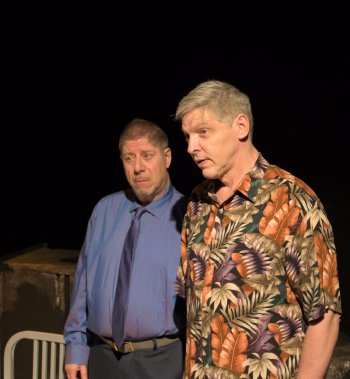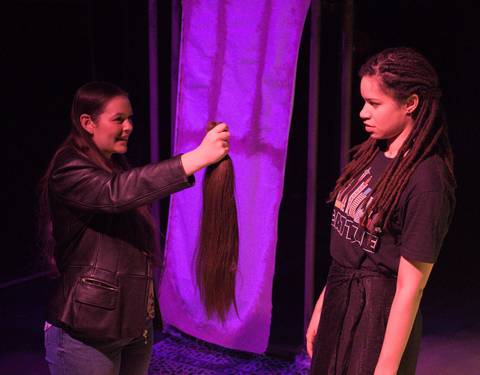Witchland
A play centered on a gay white couple and their adopted Black daughter who move to the area of the most polluted site in the Western Hemisphere.

David Silberger, Mars Holscher and Geoffrey Grady in a scene from Tim Mulligan’s “Witchland” at Chain Theatre (Photo credit: Jordan Schreiber)
[avatar user=”Scotty Bennett” size=”96″ align=”left”] Scotty Bennett, Critic[/avatar]
If you think living near a massive collection of nuclear materials will cause you to glow at night or create mutated creatures, this is the show for you. Witchland, written by Tim Mulligan, is a play centered on a gay white couple and their adopted Black daughter who move from the multiethnic and progressive Seattle, Washington, to a very straight and white area of Eastern Washington. It does a good job of blending moments of fright with humor, a staple of plays and films in the fright and horror genre.
The story is set in the town of Richland, Washington, in the shadow of the Hanford Nuclear Facility which for many years was the source of radioactive materials used in U.S. nuclear weapons. This location is considered the most polluted area in the Western Hemisphere.
The play is directed by Ken Wolf, the artistic director of the Manhattan Repertory Theatre, the show’s producer. Ken Wolf’s attempts at staging this production in a small theater are laudable, but ultimately, the shocking and scary features of the play are muted. In addition to directing, Wolf is also the sound and lighting designer. The sound does fit with the subject matter with a strangeness that includes sirens and random noises, but ultimately, it is too low in volume to have a real impact. The lighting effects don’t add to the atmosphere of foreboding.

Theresa Della Valle, David Silberger and Chelsea Clark in a scene from Tim Mulligan’s “Witchland” at Chain Theatre (Photo credit: Jordan Schreiber)
Witchland is better suited for a bigger theater space where the different sets can be clearly articulated. It also has the feel of a haunted house production that is more appropriate to Halloween, an aspect that is also apparent in some of the performances.
The play starts with an establishing scene of two high school students, Shannon (Nina Randazzo) and Brett (Ben Wambeke), outside the witch’s house, testing the idea that she will place a curse on anyone who touches the teepee of sticks in front of her door, with Shannon taking a stick. The consequences of that action appear later in the show.
Van (Geoffrey Grady), a restaurant manager with a drinking problem, and Jared (Dave Silberger), an environmental engineer, are a gay white couple from Seattle who move to Richland, Washington with their Black daughter Ali (Mars Holscher), where Jared has taken a job at the Hanford Nuclear Facility at a substantial increase in his income. They have left behind a cramped apartment in Seattle for a house in Richland with a view of the Columbia River from one side to the view of a strange house across the street. It is believed to be the home of a witch.

David Silberger and Geoffrey Grady in a scene from Tim Mulligan’s “Witchland” at Chain Theatre (Photo credit: Jordan Schreiber)
At a critical moment, the stress leads Jared to rush across the street, grab the teepee of sticks from the “witch’s” front door, and throw them away. Shortly after, there is an accident in the area where Jared is working, potentially contaminating him. While on leave following the accident, he begins to act strangely. Ali and Van don’t know if his behavior is because of the accident or a curse. Ultimately, Ali decides it is a curse and figures out how to break it from Jared and Shannon with a ritual at a place called the Dead Baby’s Cemetery.
Silberger and Grady give good performances as their characters, although Grady is somewhat weak in the opening scenes but gets better as the show progresses. Mars Holscher’s standout performance is her solidly embodied character of Ali and she supports some of the actors in their portrayals.
Through all of this, there are moments designed to be scary. Other characters move in and around the audience, acting in unexpected ways, adding an element of strangeness to the proceedings. The problem with these actions is that the venue is unsuitable for applying an effective fright factor to support the witch storyline. These actions are accompanied by lighting effects, which also fail to support the scare tactics.

Nina Randazzo and Mars Holscher in a scene from Tim Mulligan’s “Witchland” at Chain Theatre (Photo credit: Jordan Schreiber)
In addition to those mentioned, the rest of the ensemble tries to achieve a suitable level of weirdness to support the story. The cast includes Chelsea Clark, Nathan Cusson, and Danny McWilliams who play different roles throughout the play. Their efforts tend to come across as somewhat amateurish, which I believe is a function of the performance area and sets. Their actions would be more effective in a larger venue with better sets and lighting effects.
One additional and central character is The Witch, solidly embodied by Theresa Della Valle. She provides an effective witchy presence with weird non-English incantations, shrieks and howls, and baby cries.
Charli Burkhardit’s sets do not visually support the story. There needs to be more distinction between the apartment in Seattle and the house in Richland. The house needs to have a much stronger presence. The witch’s house also leaves much to be desired. The door is a painted drape covering a door frame when an actual door would have made the scene much more believable. These issues may be a function of the size of the venue.
Witchland (through April 14, 2024)
Manhattan Repertory Theatre
Chain Theater, 312 W. 36th Street, 3rd Floor, in Manhattan
For tickets, visit https://witchlandplay.com/get-tickets/
Running time: 90 minutes without an intermission






Leave a comment